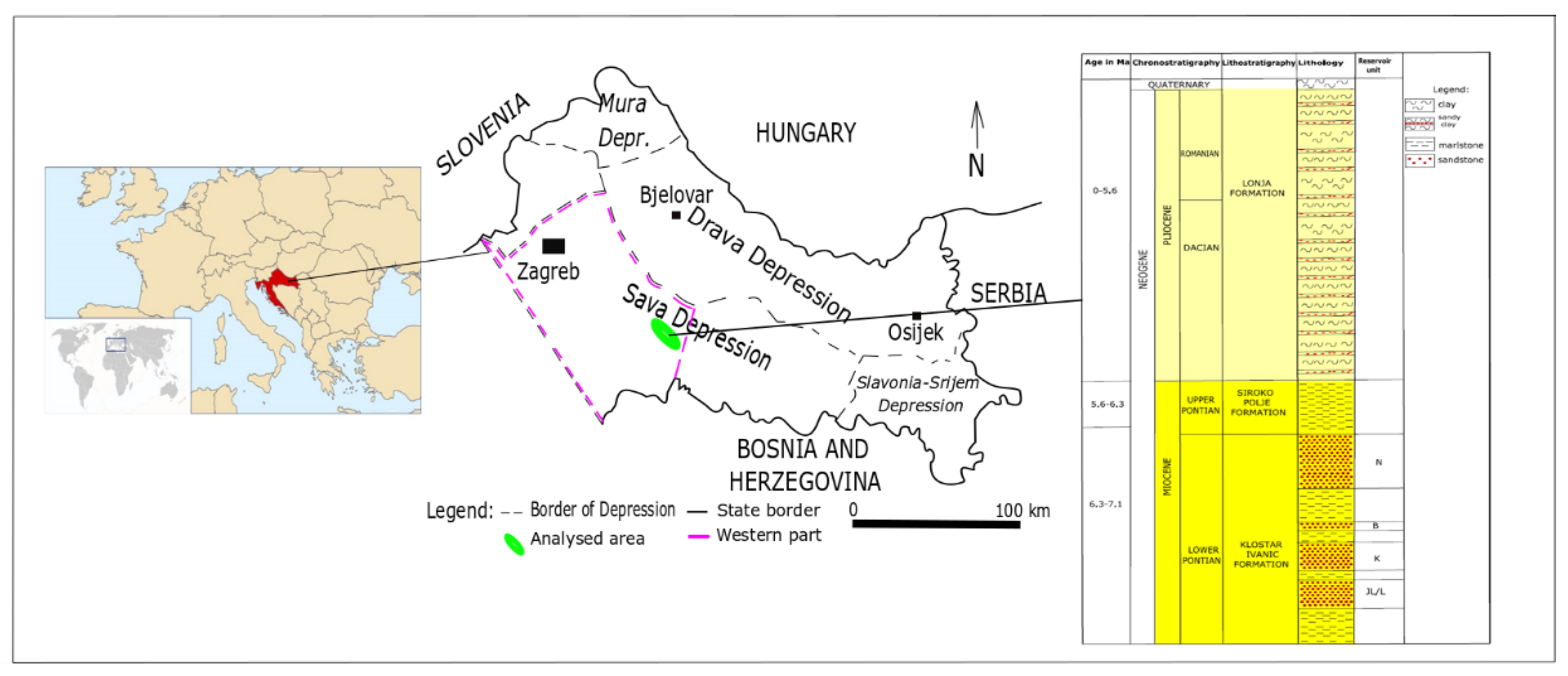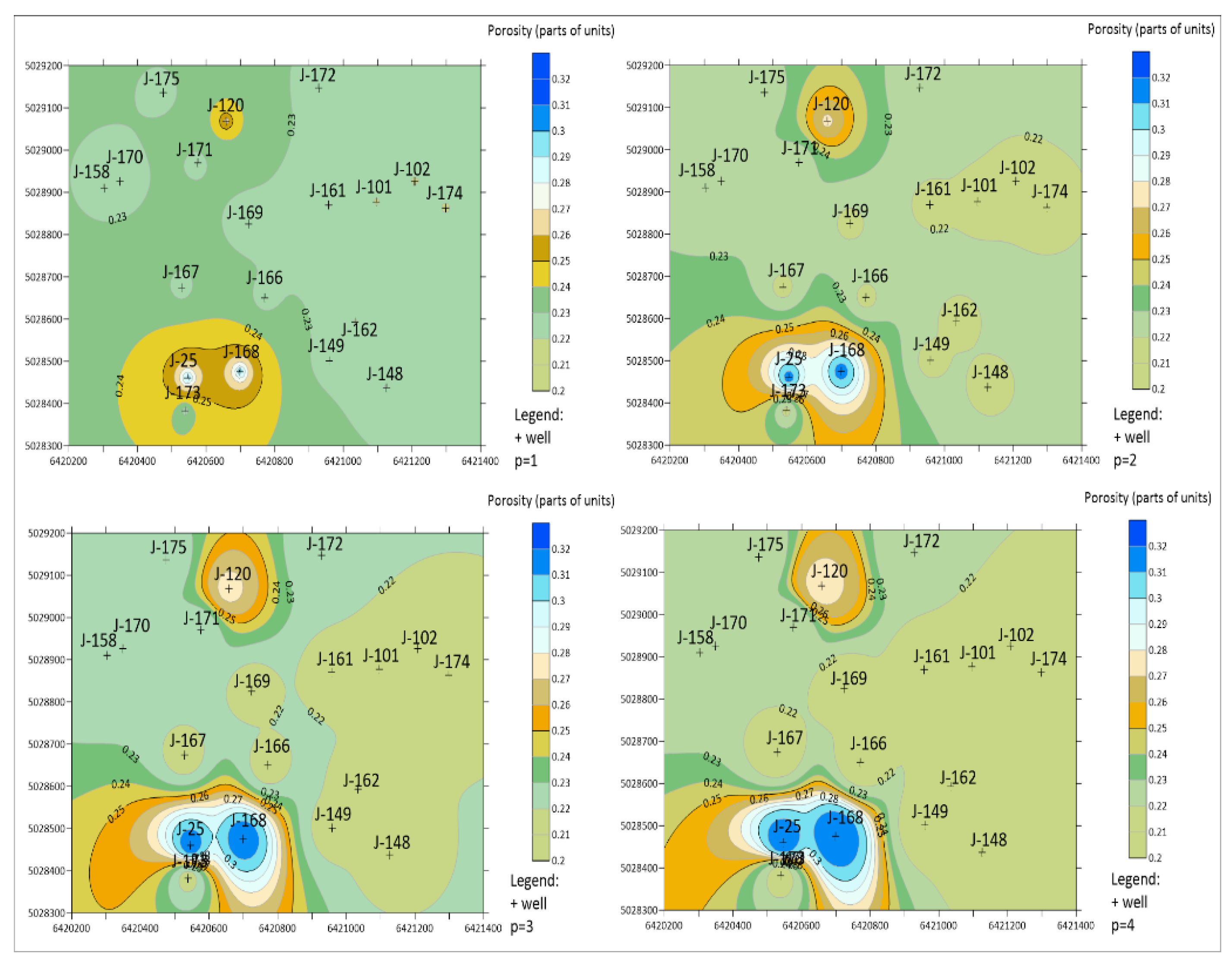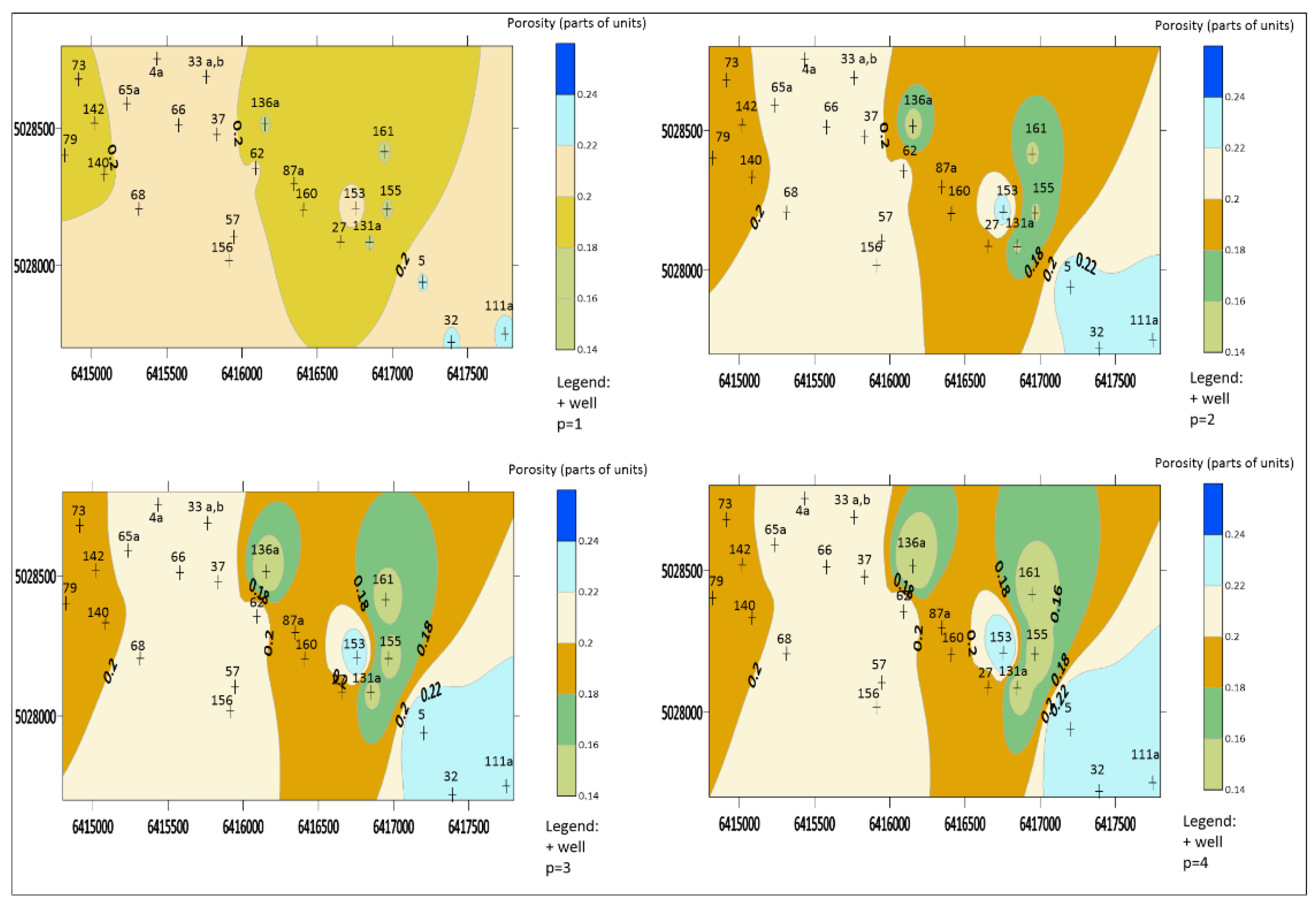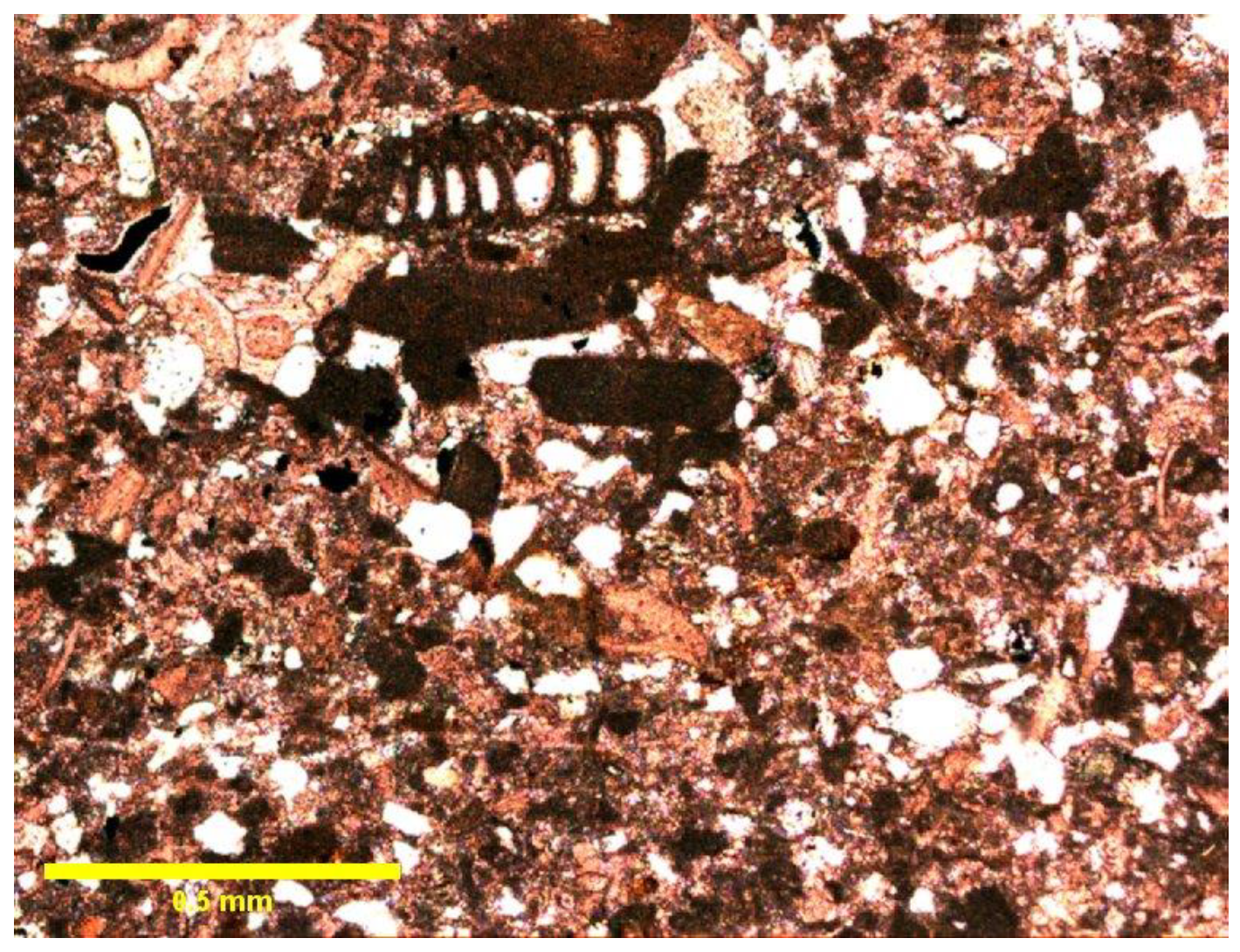Submitted:
25 April 2024
Posted:
26 April 2024
You are already at the latest version
Abstract
Keywords:
1. Introduction
- ZIDW estimated value,
- d1…dn distance between estimated value and known value 1…n,
- p power distance exponent,
- z1…zn known values at locations 1…n.
2. Materials and Methods
2.1. Coefficient of Interquartile Deviation
- VQ coefficient of interquartile deviation,
- Q1 the value of the lower (first) quartile of the sample,
- Q3 the value of the upper (third) quartile of the sample.
2.2. Root Mean Square Error (RMSE)
- MSE - Mean Square Error value,
- n - number of known values,
- SV - measured value of point „i“,
- P - estimated value of point „i“,
- i - ith point.
- RMSE - Root Mean Square Error value,
- MSE - Mean Square Error value.
2.3. Mean Absolute Error (MAE)
- MAE - Mean Absolute Error,
- n - number of known values,
- SV - measured value of point „i“,
- P - estimated value of point „i“,
- i - ith point.
2.4. Median Absolute Deviation (MAD)
- MAD - Median Absolute Deviation,
- SV - measured value of point „i“,
- P - estimated value of point „i“,
- i - ith point.
3. Geographic Location, Geological Settings and Raw Data of Analysed Reservoirs
4. Results and discussion
4.1. Qualitative Analysis of Maps
4.2. Quantitative Analysis of Maps
4.3. Qualitative-Quantitative Approach in Selection of p-Value
5. Conclusions
- -
- For a small data set, it is recommended to use a p-value of 2, because in this case, the butterfly effect is eliminated, and the RMSE value of 0.00119, MAE value of 0.02103, and MAD value of 0.00546 are smaller with respect to larger p values.
- -
- The p value of 3 and 4 is optimal in the case of a large data set, because the transition zones are clear and the input data set is included, and this is confirmed by the following values: RMSE (0.02435, 0.02437), MAE (0.01582, 0.01509) and MAD (0.00896, 0.00444).
- -
- Data dispersion in the case of a small and large data set is present, but when changing the value of p, it gradually affects the obtained interpolation maps.
- -
- The IDW method in both cases gave usable results and due to the similar lithologies in most of the Sava Depression (northern Croatia), it is recommended to apply the IDW method with p-values between 2-4, depending on the size of the analysed porosity data set.
Author Contributions
Funding
Data Availability Statement
Acknowledgments
Conflicts of Interest
References
- Bartier, P. M.; Keller, C. P. Multivariate interpolation to incorporate thematic surface data using inverse distance weighting (IDW). Computers & Geosciences 1996, 22(7), 795–799.
- Gossel, W., Falkenhagen, M. Line-Geometry-Based Inverse Distance Weighted Interpolation (L-IDW): Geoscientific Case Studies. In Proceedings of the Mathematics of Planet Earth. Springer, Berlin, Germany, 08 October 2013. [CrossRef]
- Karami, R.; Afzal, P. Estimation of Elemental Distributions by Combining Artificial Neural Network and Inverse Distance Weighted (IDW) Based on Lithogeochemical Data in Kahang Porphry Deposit, Central Iran. Universal Journal of Geoscience 2015, 3, 59 – 65. [CrossRef]
- Srinivas, V. S.; Sarma, A. D.; Achanta, H. K. Modeling of Ionospheric Time Delay Using Anisotropic IDW with Jackknife Technique. IEEE Transactions on Geoscience and Remote Sensing 2016, 54, 513–519. [Google Scholar] [CrossRef]
- Mircovski, V.; Gicevski, B.; Dimov, G. Hydrochemical characteristics of the groundwaters in Prilep’s part of Pelagonia valley – Republic of Macedonia. Rudarsko-geološko-Naftni Zbornik 2018, 33, 111–119. [Google Scholar] [CrossRef]
- Maliqi, E.; Idrizi, B.; Penev, P. Compilation of groundwater monitoring maps for the Mitrovica region in Kosova. Geoscience and Remote Sensing 2019, 2, 41–55. [Google Scholar] [CrossRef]
- Liming S., Yingqi, W.; Hong C.; Jun, Y.; Jianzhang, X. Improved Fast Adaptive IDW Interpolation Algorithm based on the Borehole Data Sample Characteristic and Its Application. In Proceedings of the 3rd International Conference on Data Mining, Communications and Information Technology, Beijing, China, 24–26 May 2019. [CrossRef]
- Pulatov, A.; Khamidov, A; Akhmatov, D.; Pulatov, B.; Vasenev, V. Soil salinity mapping by different interpolation methods in Mirzaabad district, Syrdarya Province. In Proceedings of the International Scientific Conference Construction Mechanics, Hydraulics and Water Resources Engineering, Tashkent, Uzbekistan, 23-25 April 2020. [CrossRef]
- Gonzales, R.; Rahardi, M. R. G.; Octova, A. Estimation of tin resources using Inverse distance weighted (IDW) and nearest neighbor point (NNP) methods in Bangka Tengah district, Bangka Belitung islands province. Georest 2023, 2, 2–7. [Google Scholar] [CrossRef]
- Achilleos, G.A. The Inverse Distance Weighted interpolation method and error propagation mechanism – creating a DEM from an analogue topographical map, Journal of Spatial Science 2011, 56, 283-304. [CrossRef]
- Maleika, W. Inverse distance weighting method optimization in the process of digital terrain model creation based on data collected from a multibeam echosounder. Appl Geomat 2020, 12, 397–407. [Google Scholar] [CrossRef]
- Liu, Z.; Zhang, Z.; Zhou, C.; Ming, W.; Du, Z. An Adaptive Inverse-Distance Weighting Interpolation Method Considering Spatial Differentiation in 3D Geological Modeling. Geosciences 2021, 11, 51. [Google Scholar] [CrossRef]
- Yadav, S.K.; Singh, S.; Gupta, R. Measures of Dispersion. In: Biomedical Statistics; Springer, Singapore, 2019; pp. 59-71. [CrossRef]
- Botta-Dukát, Z. Quartile coefficient of variation is more robust than CV for traits calculated as a ratio. Sci Rep 2023, 13, 4671. [Google Scholar] [CrossRef] [PubMed]
- Browne, M. W. Cross-Validation Methods. Journal of Mathematical Psychology 2000, 44(1), 108–132. [Google Scholar] [CrossRef] [PubMed]
- Rodríguez, J.D.; Martínez, A.P.; Lozano, J.A. Sensitivity Analysis of k-Fold Cross Validation in Prediction Error Estimation. IEEE Transactions on Pattern Analysis and Machine Intelligence 2010, 32, 569–575. [Google Scholar] [CrossRef] [PubMed]
- Chai, T.; Draxler, R.R. (2014). Root mean square error (RMSE) or mean absolute error (MAE)?– Arguments against avoiding RMSE in the literature. Geoscientific Model Development 2014, 7, 1247-1250. [CrossRef]
- Ćalasan, M.; Abdel Aleem, S. H. E.; Zobaa, A. F. On the root mean square error (RMSE) calculation for parameter estimation of photovoltaic models: A novel exact analytical solution based on Lambert W function. Energy Conversion and Management 2020, 210, 112716. [Google Scholar] [CrossRef]
- Willmott, C. J.; Kenji, M. Advantages of the mean absolute error (MAE) over the root mean square error (RMSE) in assessing average model performance. Climate Research 2005, 30, 79–82. [Google Scholar] [CrossRef]
- Hodson, T. O. Root-mean-square error (RMSE) or mean absolute error (MAE): when to use them or not. Geoscientific Model Development 2022, 15. [Google Scholar] [CrossRef]
- Pham-Gia, T.; Hung, T.L. The mean and median absolute deviations. Mathematical and Computer Modelling 2001, 34, 921–936. [Google Scholar] [CrossRef]
- Elamir, E. Mean Absolute Deviation about Median as a Tool of Explanatory Data Analysis. International Journal of Recent Research and Applied Studies 2012, 11, 517–523. [Google Scholar]
- Ivšinović, J.; Malvić, T. Application of the radial basis function interpolation method in selected reservoirs of the Croatian part of the Pannonian Basin System. Mining of mineral deposits 2020, 14, 37–42. [Google Scholar] [CrossRef]
- Ivšinović, J.; Pimenta Dinis, M.A.; Malvić, T.; Pleše, D. (2021) Application of the bootstrap method in low-sampled Upper Miocene sandstone hydrocarbon reservoirs: a case study. Energy Sources, Part A: Recovery, Utilization, and Environmental Effects 2021, 41 1-15. [CrossRef]
- Malvić, T.; Ivšinović, J.; Velić, J.; Rajić, R. Kriging with a Small Number of Data Points Supported by Jack-Knifing, a Case Study in the Sava Depression (Northern Croatia). Geosciences 2019, 9, 36. [Google Scholar] [CrossRef]
- Malvić, T.; Ivšinović, J.; Velić, J.; Rajić, R. Interpolation of Small Datasets in the Sandstone Hydrocarbon Reservoirs, Case Study of the Sava Depression, Croatia. Geosciences 2019, 9, 201. [Google Scholar] [CrossRef]
- Ivšinović, J.; Malvić, T. Comparison of mapping efficiency for small datasets using inverse distance weighting vs. moving average, Northern Croatia Miocene hydrocarbon reservoir. Geologija 2022, 65, 47–57. [Google Scholar] [CrossRef]
- Rezaei, M., & Fallahi, S. (2023). Block model optimization and resource estimation of the Angouran Mine by transferring the exploratory data from the local coordinate system to the UTM. Rudarsko-geološko-Naftni Zbornik, 38(3), 1–17. [CrossRef]
- Heštera, H., Pahernik, M., Kovačević Zelić, B., & Maurić Maljković, M. (2023). The Unified Soil Classification System Mapping of the Pannonian Basin in Croatia using Multinominal Logistic Regression and Inverse Distance Weighting Interpolation. Rudarsko-geološko-Naftni Zbornik, 38(3), 147–159. [CrossRef]




| Reservoir K | ||||
|---|---|---|---|---|
| Well | X | Y | Porosity (part of units) | Age |
| J-101 | 6421096 | 5028877 | 0.217 | Lower Pontian |
| J-120 | 6420658 | 5029068 | 0.272 | Lower Pontian |
| J-161 | 6420957 | 5028870 | 0.217 | Lower Pontian |
| J-162 | 6421034 | 5028593 | 0.217 | Lower Pontian |
| J-167 | 6420529 | 5028674 | 0.217 | Lower Pontian |
| J-168 | 6420699 | 5028475 | 0.315 | Lower Pontian |
| J-169 | 6420724 | 5028825 | 0.217 | Lower Pontian |
| J-170 | 6420349 | 5028926 | 0.223 | Lower Pontian |
| J-174 | 6421298 | 5028863 | 0.217 | Lower Pontian |
| J-175 | 6420475 | 5029136 | 0.223 | Lower Pontian |
| J-158 | 6420303 | 5028910 | 0.223 | Lower Pontian |
| J-171 | 6420576 | 5028970 | 0.223 | Lower Pontian |
| J-172 | 6420928 | 5029147 | 0.223 | Lower Pontian |
| J-102 | 6421208 | 5028926 | 0.217 | Lower Pontian |
| J-148 | 6421126 | 5028437 | 0.217 | Lower Pontian |
| J-149 | 6420959 | 5028501 | 0.217 | Lower Pontian |
| J-166 | 6420771 | 5028650 | 0.217 | Lower Pontian |
| J-25 | 6420546 | 5028460 | 0.315 | Lower Pontian |
| J-173 | 6420539 | 5028382 | 0.217 | Lower Pontian |
| Reservoir L | ||||
| Well | X | Y | Porosity (part of units) | Age |
| L-111a | 6417748 | 5027750 | 0.239 | Lower Pontian |
| L-131a | 6416847 | 5028084 | 0.156 | Lower Pontian |
| L-136a | 6416153 | 5028515 | 0.145 | Lower Pontian |
| L-140 | 6415085 | 5028332 | 0.192 | Lower Pontian |
| L-142 | 6415019 | 5028519 | 0.186 | Lower Pontian |
| L-32 | 6416755 | 5028208 | 0.239 | Lower Pontian |
| L-155 | 6416967 | 5028205 | 0.156 | Lower Pontian |
| L-156 | 6415912 | 5028018 | 0.206 | Lower Pontian |
| L-160 | 6416410 | 5028203 | 0.197 | Lower Pontian |
| L-161 | 6416946 | 5028415 | 0.156 | Lower Pontian |
| L-27 | 6416655 | 5028086 | 0.197 | Lower Pontian |
| L-153 | 6417390 | 5027720 | 0.239 | Lower Pontian |
| L-33a | 6415763 | 5028687 | 0.214 | Lower Pontian |
| L-33b | 6415763 | 5028687 | 0.214 | Lower Pontian |
| L-37 | 6415834 | 5028477 | 0.214 | Lower Pontian |
| L-4a | 6415435 | 5028754 | 0.214 | Lower Pontian |
| L-5 | 6417200 | 5027939 | 0.239 | Lower Pontian |
| L-57 | 6415946 | 5028104 | 0.206 | Lower Pontian |
| L-62 | 6416091 | 5028355 | 0.206 | Lower Pontian |
| L-65a | 6415235 | 5028590 | 0.214 | Lower Pontian |
| L-66 | 6415579 | 5028512 | 0.214 | Lower Pontian |
| L-68 | 6415315 | 5028206 | 0.214 | Lower Pontian |
| L-140 | 6414912 | 5028679 | 0.192 | Lower Pontian |
| L-79 | 6414821 | 5028402 | 0.195 | Lower Pontian |
| L-87alfa | 6416347 | 5028297 | 0.197 | Lower Pontian |
| Reservoir | Q1 | Q3 | VQ |
|---|---|---|---|
| K | 0.217 | 0.223 | 0.013 |
| L | 0.192 | 0.214 | 0.054 |
| Reservoir | p | RMSE | MAE | MAD |
|---|---|---|---|---|
| K | 1 | 0.03228 | 0.01700 | 0.00360 |
| 2 | 0.03458 | 0.02013 | 0.00546 | |
| 3 | 0.03677 | 0.02196 | 0.00383 | |
| 4 | 0.03780 | 0.02276 | 0.00667 | |
| 5 | 0.03839 | 0.02319 | 0.00734 | |
| L | 1 | 0.02632 | 0.01924 | 0.00869 |
| 2 | 0.02505 | 0.01735 | 0.01012 | |
| 3 | 0.02435 | 0.01582 | 0.00896 | |
| 4 | 0.02437 | 0.01509 | 0.00444 | |
| 5 | 0.02470 | 0.01490 | 0.00343 |
Disclaimer/Publisher’s Note: The statements, opinions and data contained in all publications are solely those of the individual author(s) and contributor(s) and not of MDPI and/or the editor(s). MDPI and/or the editor(s) disclaim responsibility for any injury to people or property resulting from any ideas, methods, instructions or products referred to in the content. |
© 2024 by the authors. Licensee MDPI, Basel, Switzerland. This article is an open access article distributed under the terms and conditions of the Creative Commons Attribution (CC BY) license (http://creativecommons.org/licenses/by/4.0/).





